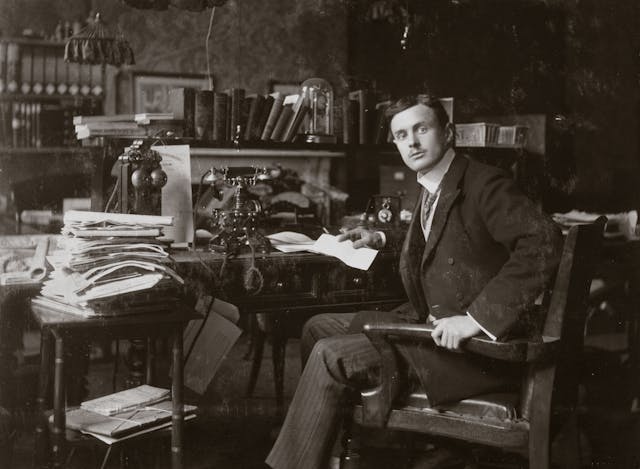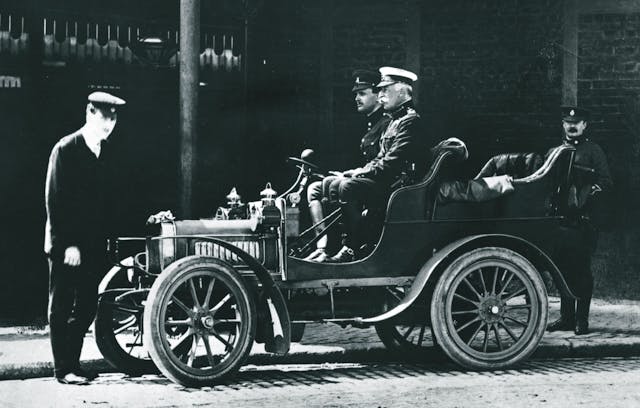120 Years Ago, Rolls Met Royce
It’s perhaps the most auspicious date in British motoring history. May 4 1904 was the day that The Hon. Charles Stewart Rolls and Henry Royce first met and the hyphenation was almost immediate.
Actually, the Rolls-Royce origin story truly begins in 1902 as that’s when, 200-miles apart, both Rolls and Royce were making their first moves in the fledgling automobile business.


In London, Rolls, an aviation enthusiast and early racing pioneer, set up one of the capital’s first car dealerships, selling Peugeots and Minervas imported from France and Belgium. These cars were perfect for his well-heeled clients in posh Fulham, but Rolls would much rather that they bought British.
In Manchester, electrical engineer Henry Royce had similar ideas. Cheaper imports were undercutting his business and he needed to diversify. Inspired by reading The Automobile: Its Construction and Management by Lavergne Gerard, Royce purchased a 10 H.P. Decauville from France and set about dismantling it, and working out how to improve it. He redesigned the bearings, radiator, carburation, transmission, reduced the weight, and built his own twin-cylinder engine.

The Royce 10 H.P. had its first road test on April 1 1904 and its inventor began loaning it out to potential customers. Among them was Henry Edmunds, a friend of Rolls who waxed lyrical to his chum about the new motor car. Rolls travelled to Manchester to see it for himself.
When Rolls met Royce the chemistry was instant. The aristocratic Cambridge graduate and the northern engineer couldn’t have been much further apart in background, or indeed, in manner, yet they bonded over their passion for the car. That very day Rolls declared that he would sell every car Royce could build and to mark their partnership a new company would be formed: Rolls-Royce.
Before the year was out the first Rolls-Royce 10 H.P. was on sale, featuring a raft of improvements over Royce’s first iteration. “Take the best and make it better,” was Royce’s dogma that the company still lives by 120 years later.
***
Check out the Hagerty Media homepage so you don’t miss a single story, or better yet, bookmark it. To get our best stories delivered right to your inbox, subscribe to our newsletters.



I personally find the aircraft engines more interesting than the cars.
Then why are you on Hagerty?!
Their machines are absolute engineering marvels, right up to the current day. My 1970 rolls has 2500 psi aircraft style brakes, and this is just one of many incredible engineering feats over the years. The 8 cyl engine developed in the early 1950s for the silver cloud was the single longest running production engine in the history of internal combustion. It was used right up through 2019 Bentley. The aircraft engines are cool also, but this does not detract from the quality engineering on the automobiles.
well he can like both I suppose
From 1935, the same time Cadillac, LaSalle, Lincoln, Packard were launching more rational, nimbler, affordable, company-saving models; respectively the Model 60, the Olds-based 1934-36 LaSalle, the Zephyr, the One Twenty, even the 1936 Cord initially termed “the baby Duesenberg” by Auburn-Cord-Duesenberg insiders, Rolls-Royce, already a designer of aero engines, greatly increased that focus, to the extent that, after the war, Crewe’s automobiles were a rationalized, assembled, boutique, sideline product with most bodies stamped by Pressed Steel of Cowley near Oxford, who furnished much of the Sceptered Isle’s motor industry, even as Briggs produced Packard’s bodies 1941-on, Murray, Hayes, etc. supplied other US automakers.
Crewe’s automotive products became slightly downmarket, but their advertising and marketing remained adroit.
The renowned English auto writer, Laurence Pomeroy, summed Rolls-Royce as “a triumph of craftsmanship over engineering,” and “a bloody good confidence trick.” When Rolls-Royce introduced their junior “owner-driver” “small HP” model 20 in 1922, its engine was based on the ’20 Buick Six, tho’ in the words of Pomeroy or another period observer, “not so good.” This engine was the basis of all R-R and post 1933 Bentleys other than the complex, troublesome 727 1936-39 447-ci ohv Phantom IV V-12s, through 1959, when Rolls-Royce introduced their first V-8. At its debut, the R-R V-8’s well lubricated designer blurted out, “It’s bloody near as good as the Chrysler.” This engine was not “developed in the early ’50s,” Crewe then devoted to a quarter-inch bore increase of their existing B60 F-head inline six.
In the years just before War II, Rolls-Royce was annually dismantling a new Buick Limited to glean the latest Detroit production tips.
So Gary’s interest understandable. Your ’70 is a well wrought product, but for its price, should be. You well know your braking system and 1,850-2,500 psi hydraulic suspension are demanding, terribly expensive to work on. Making a cost little object product is not nearly as difficult as purveying more affordable quality, among the reasons L. J. K. Setright’s favorite marques were Chrysler, and in the modern era, Honda.
None of this takes away from your apparently well fettled example, but is it demonstrably better than a luxe Detroit product? After the war, R-R used a nut for bolt copy of Packard’s prewar “Safe-T-Flex” i.f.s., as did at the rear, Lagonda. Crewe also used Delco electrics, and when first offering automatic transmission, a GM HydraMatic.
Craftsmanship for those needing such statement. We recall seeing Rolls-Royces with “unborn calf hide” upholstery. Cars fit for Caligula.
Meanwhile, this gem from Hagerty’s own Aaron Robinson:
http://www.hagerty.com › media › opinionAuto leather isn’t all it’s cracked up to be – Hagerty
Sep 28, 2021 · When it’s hot out, leather is hotter. When it’s cold out, leather is colder. It makes annoying scrunching noises when you move in the seat. It requires periodic smears of icky goo such
Long week, Sean. Hence typo in above defense of Gary Bechtold being understandably more interested in Rolls-Royce’s aero engines, which have been the mainstay most of the company’s existence. Meant “Phantom III” in 5th line, 3rd paragraph.
BTW, in R-R’s early decades, knowledgeable Britons preferred Lanchester over R-R.
I worked at the local Rolls-Royce Naval Marine shop for a short time refurbishing variable pitch battleship props. Got some great stories from that experience.
Tinkerah, if as novel as many of R-R’s aero engines, bring them on, please. Many of us don’t shrug off power merely as it kept going where land ended. Packard, Lycoming, Continental, and GM didn’t. And Pierce Arrow’s big T-head sixes were beloved by rum runners for their power, dependability, and quiet exhaust.